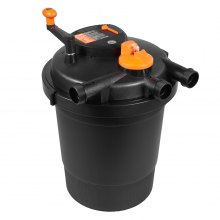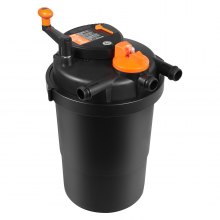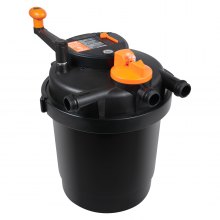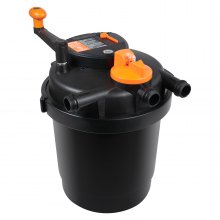VEVOR Explores Pond Filters as Eco-Friendly Water Management Tools
Water management is a major concern as environmental degradation and resource scarcity pose serious challenges to ecosystems worldwide. As human activity impacts the natural environment, innovative solutions that promote sustainability and environmental management are needed.
Ponds support a diversity of plants and animals, which are important in the wider ecological dynamics but are vulnerable to pollution, nutrient imbalances, and other damages. Consequently effective filtration system are needed to improve ponds' water quality and environmental integrity. Through our pond filters, VEVOR aims to provide environmentally friendly solutions that improve water quality and reduce environmental pollution due to human activities.
An Overview of Pond Filters And Working Mechanism
Pond filters remove pollutants, excess nutrients, and hazardous materials from ponds, improve water quality, and ensure a healthy aquatic environment. Pond filters work through a combination of mechanical, biological, and sometimes chemical processes:
Mechanical Filtration
Mechanical filters remove solid particles and debris from water by physical adsorption. This phenomenon typically occurs early in the filtration, where water passes through filter media with varying degrees of porosity.
Coarse filter media such as foam pads or brushes capture larger particles such as leaves, twigs, and algae, while finer media such as filter pads or cartridges sediment and suspended solids trap particles. As water flows through media, the particles are separated mechanically, leaving the water clear.
Biological Filtration
Biological filtration uses beneficial bacteria to break down organic waste and harmful compounds in water.
These bacteria settle on specialized filter surfaces, such as bio-pellets, ceramic rings, or porous stones, forming biofilms where ammonia and nitrite are converted into nontoxic compounds such as nitrates through the nitrification process.
Chemical Filtration (optional)
Chemical filters use specialized filters or additives to remove specific contaminants or pollutants from water. This may include activated carbon, which absorbs dissolved organic compounds, toxins, and odors, or an ion exchange resin, which can remove heavy metals or excess nutrients such as phosphates.
Different Types Of Pond Filters
There are different categories of pond filter users. Hence, there is a need for various features in pond filters. Fortunately, manufacturers recognize this need and make various pond filters to suit versatility.
External Pressurized Filters
Pressurized pool filters are installed at the back of the pond, usually on the ground. Water is pumped from the pond to a filtration plant, where it is mechanically and biologically filtered before being returned to the pond. These filters are suitable for medium to large ponds, making them more efficient and flexible in filter selection.
Submersible Filters
These filters are directly submerged in the pool. They usually feature pumps, mechanical inputs, and sometimes biological components. Submersible filters are suitable for small to large pools and are generally easy to install and maintain.
Gravity-Fed Filters
Gravity filters rely on gravity to push water through the filters. They are usually installed at a higher elevation than the pond, allowing water to flow through the filters.
Beyond Filtration: Additional Tips for a Healthy Pond Ecosystem
Pond filtration is one way to ensure a healthy pond. However, it is not the only way. There are other things you should also pay advantage to when ensuring your water body remains safe and healthy.
Introduce Aquatic and Marginal Plants
Introducing a varied assortment of aquatic plants serves several functions in a pond ecology. Plants like water lilies, duckweed, and submerged oxygenators not only produce oxygen through photosynthesis, but they also help absorb excess nutrients like nitrates and phosphates, lowering the likelihood of algal blooms. Aquatic plants also provide refuge and food for fish and other aquatic species, which helps to increase total biodiversity.
Consider planting marginal plants around the pond's margins. These include cattails, rushes, and irises. These plants not only improve the coastline's aesthetics but also assist in stabilizing it, prevent erosion, and offer a home for amphibians, insects, and other creatures. Their root systems may also absorb nutrients and catch sediment runoff, which improves water purity and quality.
Aeration
Introducing a varied assortment of aquatic plants serves several functions in a pond ecology. Plants like water lilies, duckweed, and submerged oxygenators not only produce oxygen through photosynthesis, but they also help absorb excess nutrients like nitrates and phosphates, lowering the likelihood of algal blooms. Aquatic plants also provide refuge and food for fish and other aquatic species, which helps to increase total biodiversity.
Avoid Chemicals
Look into growing marginal plants around the pond's margins. These include cattails, rushes, and irises. These plants not only improve the coastline's aesthetics but also assist in stabilizing it, prevent erosion, and offer a home for amphibians, insects, and other creatures. Their root systems may also absorb nutrients and catch sediment runoff, which improves water purity and quality.
Why Choose VEVOR?
VEVOR offers comprehensive filtration solutions encompassing various filtration stages and technologies to address different aspects of pond water quality. From mechanical filtration for removing debris to biological filtration for managing waste and promoting microbial balance, VEVOR's filters provide multi-stage filtration processes that address diverse filtration needs. Additionally, VEVOR offers optional features such as UV clarifiers and chemical filtration media to further enhance water quality and clarity, providing comprehensive solutions for pond management.
VEVOR is dedicated to customer satisfaction and strives to exceed customer expectations with its products and services. With a commitment to quality, reliability, and performance, VEVOR ensures that its pond filters meet the highest standards of excellence and functionality.
Additionally, VEVOR offers responsive customer support, technical assistance, and warranty coverage to ensure a positive experience for pond owners and users.
FAQs About Pond Filters
Can I use multiple pond filters in my pond?
Yes, you can have multiple filters in your pond, especially if it is large or requires specific filtering needs. Integration of various filtering techniques, such as mechanical, biological, and ultraviolet, can improve water quality by achieving advanced filtration. However, it is important to ensure that multiple filters are properly sized, installed, and connected to avoid excessive leakage or inefficiency in your pond system.
Are pond filters safe for fish and other aquatic life?
Yes, pond filters are generally safe for fish and other aquatic life when properly installed, maintained, and used. Mechanical filters remove physical and particulate matter that can harm fish, and biological filters grow beneficial bacteria, which help destroy harmful wastes such as ammonia and nitrate. UV clarifiers can also prevent algae and pathogens, improving water quality and fish health. Choosing the right filter type and size and monitoring water parameters are important to ensure your pool residents' safe and healthy environment.
Do pond filters require any special installation or setup?
Pond filter installation and setup procedures vary by type and model. Submersible filters are often simple to install and need little preparation, but exterior and gravity-fed filters may have more sophisticated installation methods, such as plumbing connections and location. To guarantee that your pond filter performs optimally, follow the manufacturer's instructions and advice for correct installation and configuration.













































































